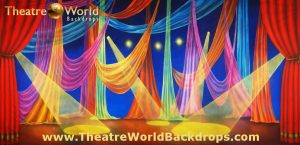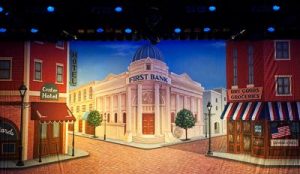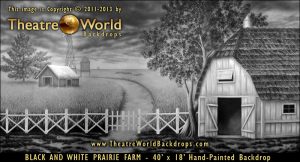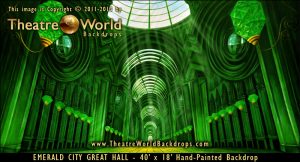Getting Creative With Stage Lighting
Planning and implementing visual effects takes time and skill – and it’s just one part of the tech crew’s job! The good news? With smart stage lighting, you can bring first class presentation and personalization to your stage even if you don’t have a full-time, professional tech crew at your disposal. Proper use of stage lighting can have a huge impact on your productions and improve the overall look of your stage.
One of the first rules of stage lighting is that there are not any formal rules. Your equipment and creativity are the only things that limit what you can do. Having said that, many lighting crews follow a basic structure. We can break this structure down into types of lighting. We differentiate these different types by their focus and purpose.
- A dedicated set of lights provides area lighting. Direct this at your cast, musicians, dancers, or whoever else may be performing on your stage.
- The next selection of lights are used for toning and blending. This aspect of stage lighting illuminates the parts of your stage that are outside of the focus of your area lighting. It also serves to visually set the mood for scenes. You can create different times of day and emotional experiences by properly lighting the general stage area. When done correctly, toning and blending lighting will work seamlessly with your area lighting, while still making it visually clear that all eyes should be on the focal point of the scene.
- The third tier of lighting is background lighting, which, naturally, is dedicated specifically to your backdrops. You can brighten them up, tone them down, and even change their overall color with the assistance of your house lighting system. This tier of lighting can set or reinforce the mood that you are conveying to the audience. It can also change your background scenery just enough that you can use it for multiple scenes.
Effectively combining these three levels of stage lighting gives you a new sense of control over the visual aesthetics that you present. We have worked with clients who have combined lighting techniques with the design of our backdrops to create one of a kind sets.
One of our favorite examples of this involves our Le Cirque Celebration Drape. This backdrop depicts a variety of colorful stage curtains in combination with painted-on stage lighting. While we like this drop in any lighting, we really don’t do it justice on our website. We hang and photograph every drop in natural lighting so that they appear in their most “raw” form. When our Le Cirque Celebration Drape is lit with minimal lighting, you still see the design. However, you may miss some of its potential. This drop, like many in our rental inventory, was painted with high quality reflective paints that are designed to be used with proper lighting. (We also have drops that we’ve painted with materials containing real gold and silver!)
For an example of effective lighting, take a look at the photo on the right. This lighting director applied background lighting to the drop itself and then used toning and blending lighting to slightly emphasize the band area. Instantly, the backdrop is transformed into what the audience will perceive as being a 3 dimensional space. The lighting also allows the paint in the backdrop to do its job and display a marvelous range of reds and blues.
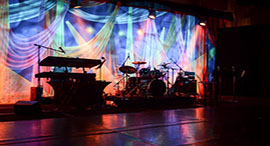
Le Cirque Lights Scenic Backdrop at Bridge Project Event
Setting Time of Day and Mood with Stage Lighting
You can use lighting to set the time of day or the mood on-stage just as easily. We have seen past clients apply blue hues for daytime scenes and then bring the exact same backdrop back later in a production. This time, though, they have used reds and yellows to create a scene that takes place in the early evening. This is attainable at all levels of theatre with proper planning and the right equipment. It adds that much more realism to your scenery.
You can see this effect here as it was used on our American Town Square to differentiate time of day.
Directors can also use background lighting to change the look of a backdrop altogether or to create a different mood. In a production of THE WIZARD OF OZ, one of our clients took our Black and White Prairie Farm and saturated it with a deep gold. As a result, the drop flawlessly represented the storm that transitions Dorothy from Kansas to Oz. They even brought in some flying effects so that the Wicked Witch could make her way through the air in front of the newly colored drop. Both of these examples only use one color at a time, yet they drastically transform the stage for the audience.
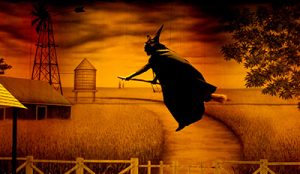
Using Toning and Blending to Create New Stage Lighting Effects
Our last example for this post is a bit more complicated. (Yet, still easy for even younger tech crews to implement.) This tech crew used of all three levels of lighting and a good bit of creativity to introduce Dorothy and company to a very ominous Wizard. They calibrated the toning and blending lighting to work in tandem with the background lighting. Our vibrant, green Emerald City Great Hall became a toned down version of the imagery with a grey hue. They then highlighted the on-stage cast members with area lighting.
To finish the effect, they projected an image of The Wizard’s head onto the backdrop. The backdrop provided fitting imagery. However, it also gave the tech crew a focal point to project “The Wizard” on to. When the scene ended, the tech crew changed the lighting so the backdrop appeared Emerald City green once again. All in all, it made for a very unique presentation.
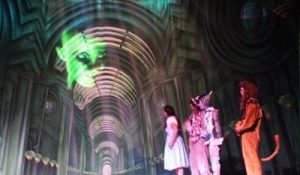
Lighting is one of the best resources available when you are setting a scene. As you can see, even the simplest strategies can impact on your presentation dramatically. The more you experiment, the more options that will present themselves. Don’t be afraid to switch things up during rehearsals. You might just find the exact visuals that you are looking for!


